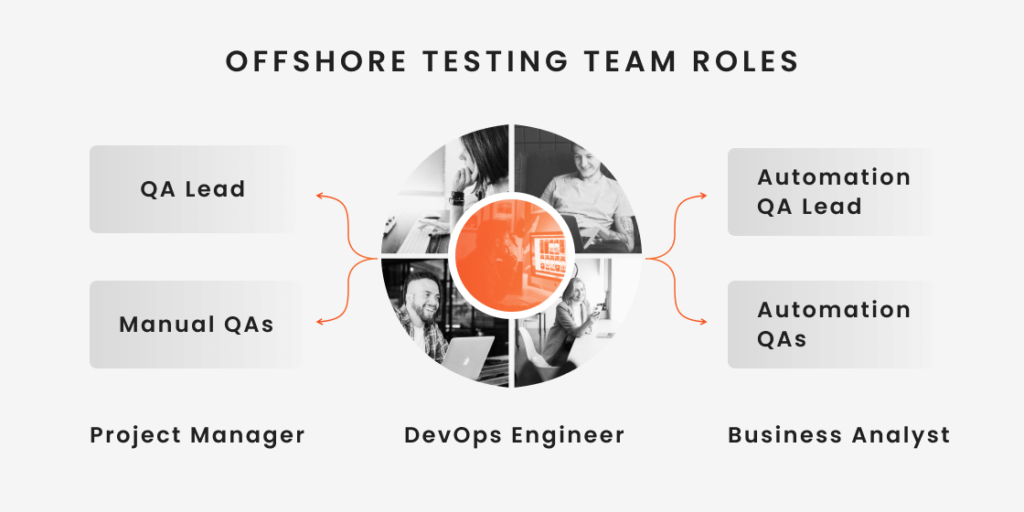Businesses around the world regularly face the challenge of wanting to ensure the highest quality of software but also needing to refrain from overspending. This struggle has become more apparent in recent years, when the threat of an economic recession causes companies to cut costs wherever possible without sacrificing the quality of their products. And for many companies, the solution for these struggles is offshore testing. In this article, we’ll discuss the benefits and drawbacks of offshore testing, how to find the right partner, and how to make the most of an offshoring project.
Key Takeaways
- Offshore quality assurance offers scalable, cost-effective QA support for companies of all sizes and domains.
- The right software testing offshore partner can help speed up releases, improve test coverage, and provide 24/7 productivity.
- Cost savings are real, but not the only reason to hire an offshore software testing team. Strategic value, flexibility, and access to niche expertise often matter more.
- Risks like miscommunication, delays, or quality gaps can be minimized through mature processes and clear expectations.
- Time zones, tools, and team overlap are critical factors when building a productive offshore testing model.
- Choosing the right location and vendor affects everything from pricing to communication to long-term results.
- Hybrid or managed offshore setups are a strong option for teams looking to scale without losing control.
- Security, IP protection, and compliance must be part of your vendor evaluation, not an afterthought.
- Offshore QA isn’t a one-size-fits-all solution, but when aligned with business goals, it delivers long-term value.
What Is Offshore Software Testing?
Offshoring is a term used in many industries and for many different services, not limited to software-related ones. However, offshore software testing services are definitely among the most popular types of offshoring. Offshore software testing is the practice of entrusting some or all of the company’s testing needs to one of the QA testing companies located in a different geographic and time zone.
Onshore vs. Offshore QA Testing
Circling back to the definition of offshore testing, we must point out that the geographic factor is crucial, as it implies that not every remote team is an offshore one. When remote testers are located in the client’s country and region, and when they work in the same hours and have the same native language, we are talking about onshore software testing instead of offshore.
In many ways, offshore and onshore testing models are very similar to one another. For example, the same choice of digital communications is available in both cases, and it’s possible to find experienced testers with a strong work ethic both with offshore and onshore collaborations. However, there are also instances where onshore QA professionals are the superior option — mainly, due to the offshore software testing company’s familiarity with local governments and the absence of time-zone issues. Naturally, these advantages come at an additional price, so offshoring is still the go-to way for companies to enhance their QA process.
| Aspect | Offshore testing | Onshore testing |
| Cost | Generally more cost-effective due to lower labor costs and overhead | Higher labor and operational costs |
| Talent Pool | Access to a wider global talent pool with diverse expertise | Limited by local availability of skilled testers |
| Scalability | Easily scale teams up or down based on project needs | Scaling often slower and more expensive |
| Communication | Requires clear communication strategies; potential language and cultural differences | Easier face-to-face and real-time communication |
| Domain Expertise | Many offshore vendors specialize in niche industries and technologies | Direct local industry knowledge may be stronger |
| Flexibility | Flexible engagement models (fixed price, dedicated teams, T&M) | Typically more rigid hiring and engagement processes |
| Infrastructure | Offshore vendors provide own infrastructure, reducing client burden | May require client to provide infrastructure or resources |
| Project Control | Effective with strong project management and collaboration tools | Direct control with on-premises teams |
Key Benefits of Offshore Software Testing
At first glance, the biggest advantage of offshoring testing seems to be cost savings. And while the desire to lower the cost of testing is probably the most common reason why companies go for an offshore over an in-house or onshore team, it’s definitely not the only one. Here is why a company or product owner is likely to find offshore testing an invaluable measure.
Cost-effectiveness
Offshore testing significantly reduces labor costs and additional expenses. Vendors handle office space, taxes, and benefits, so you only pay for the actual QA work.
Strategic partnership
Reliable offshore vendors act as long-term partners, and many offshore contracts last for years. A software testing offshore team integrates with your development process and takes full ownership of quality, unlike short-term freelancers.
Higher quality of software
Independent QA units test the product delivered by the software development team with fresh eyes and zero bias, using proven practices to uncover issues and improve the overall quality of the software.
Access to a larger talent pool
Offshore markets give you access to specialized testing professionals and domain experts you may not find locally or can barely afford, especially in the current job market.
Faster releases
With round-the-clock test cycles across time zones, offshore teams help match even the most grueling production schedule, ensure fast turnaround, meet tight deadlines, fully support the production process, and respond quickly to market changes.
Government support
Popular offshore destinations often offer business-friendly laws, tax benefits, and strong legal frameworks that support foreign tech clients.
Absolute flexibility
An offshore QA facility typically offers flexible cooperation models. The right model can ensure smart spending and help you quickly scale your QA efforts up or down depending on project scope, timelines, and budget.
Robust documentation
Offshore QA teams follow strict documentation practices, ensuring all testing aligns with functional and non-functional requirements. Clear, consistent reporting helps prevent issues caused by miscommunication or missing data.
See Offshore QA in Action
Find out how we helped a US travel app speed up releases by 35% and cut booking errors by 42% — all with just two QA experts.
Limitations and Drawbacks of the Offshore Testing Model
Like pretty much any concept in the world, offshore testing services have both advantages and disadvantages. We’ve already talked at length about the advantages of this model; now let’s focus on the typical drawbacks of offshore testing QA services.
Cultural and language differences
Offshore teams often come from different cultural and linguistic backgrounds, and while most invest in English training, their proficiency may mainly cover technical needs. To collaborate effectively, it’s important to understand local work culture, such as views on deadlines, hierarchy, and time management. These differences, though, can be successfully navigated with the help of a dedicated project manager who fosters clear communication, cultural awareness, and mutual respect.
One notable example comes from a complex enterprise project led by Bruce Mason, a senior delivery manager at TestFort. The client initially struggled with fragmented communication, cultural differences, and a rigid test cycle that slowed releases. Drawing on years of outsourced offshore QA experience, Bruce restructured collaboration by introducing shared agile rituals, refining reporting standards, and setting up timezone-aware workflows. His hands-on approach helped align cross-border teams, improve transparency, and build a long-term relationship based on trust, performance, and shared accountability.
Unlock the True Potential of Your App
Book a free consultation with our Head of Delivery.
Time zone differences
Time zone gaps — often 9 to 13 hours — can be both a challenge and an advantage. While they enable near round-the-clock testing, they may limit live communication. Many offshore vendors help bridge this by offering adjusted work hours or using asynchronous collaboration tools to stay aligned with clients.
Substandard quality of work
This is an issue you typically don’t have to worry about when you work with a carefully selected team with a proven success record. However, when the vetting process is not taken seriously or skipped altogether, or when you go for the most low-cost vendor, you can often discover that the outcome of the cooperation is not what you imagined. This can also lead to hidden costs of you having to hire another team that is able to find and fix the issues missed by the original team.
When to Hire Offshore Testers and When to Do Testing In-House
Offshore software QA is an excellent solution that meets the needs of thousands of companies around the world. At the same time, we won’t go as far as claiming that everyone needs to outsource their testing projects immediately. Here is when it makes perfect sense to use offshore QA testing services:
- You’re looking to save costs. Probably, the most popular reason for companies to go for offshore testing is that it costs significantly less compared to the cost of hiring an in-house team or working with a nearshore provider.
- You need niche expertise. Some testing projects require highly specific expertise and services, whether it’s performance, security, or compatibility testing, and you can easily find a lineup of vendors who specialize in the required services.
- You need 24/7 testing availability. A significant benefit of offshore testing is that by strategically choosing the team’s location, and, therefore, work schedule, you can achieve a nearly uninterrupted testing operation for round-the-clock quality assurance.
- You want quick scalability. An offshore testing vendor will easily adjust the collaboration to match your changing business needs. You can scale your team up or down in a matter of days, which is not the luxury you can afford with an in-house operation.
- You have a short-term project. When you are not in need of continuous, long-term testing and simply want to test a new feature or a small update, hiring an offshore team makes more business sense and can give you the anticipated results faster.
- Your project includes repetitive activities. For well-established projects with clearly defined, stable requirements and a lot of repetitive actions, such as regression testing or basic functional testing, offshore QA can be a better business match.
At the same time, there are situations where offshoring your testing needs is not the most ideal solution. Here is where you may rather consider in-house quality assurance instead:
- You have a complex or specialized project. While offshore QA teams possess a wide range of skills and expertise, some projects still require highly specific knowledge of experience. This mainly includes one-of-a-kind software products or a highly niche industry.
- Your project has advanced security needs. When dealing with protecting intellectual property, sensitive customer data, or other cases where advanced security is required, offshore testing may not be an option due to the complicated security clearance procedure that is required.
- There is a need for face-to-face collaboration. For some projects, it’s critical to have the development, testing, and sometimes DevOps teams operating from the same building and in close proximity to one another to be able to exchange ideas in real-time.
- Testing is your company’s core competency. If you’re involved in designing, creating, or testing software, quality assurance can be rightfully considered to be your core competency and therefore should not be outsourced, as you will have a harder time overseeing and managing the testing process in that case.

Assembling the Perfect Software Testing Offshore Team: Structure and Responsibilities
Building an offshore quality assurance team is one of the most fundamental decisions in the whole process. It can get even more challenging than regular hiring because you don’t get to meet the prospective candidates in real life and need to rely only on their CVs and video interviews to make the decision. Still, deciding who to hire and for which roles is something that will have a lasting effect on the whole project.
There are no universal standards when it comes to offshore teams because it all depends on the size and complexity of the project, its anticipated duration, as well as the already available testing resources. Still, proper resource planning can help avoid problems in the long run. In case you are considering handing over the entire scope of testing to an offshore team, its composition will typically include the following roles:
- Manual QAs — these are specialists who do the biggest chunk of the work on a typical testing project. Manual QAs can get to work almost immediately without a lengthy preparation period. A medium-sized QA project is going to need 3 to 5 manual QAs.
- QA Lead — a person who is in charge of managing the manual QA team. In some cases, the role of a Manual QA Lead is filled by a Senior-level member of the team; in that case, the Lead not only manages the team and communicates with the client, but also does hands-on testing work.
- Automation QAs — essential specialists for any mid-sized to large testing project, especially one with a lot of tests that are run repeatedly, such as regression tests. The automation team typically comes on board after the manual team has already completed a portion of work, although sometimes Automation QAs can start simultaneously with the Manual QAs in case there are some tests completed already — for example, by a previous QA team.
- Automation QA Lead — an engineer who oversees the work of the Automation QA team and participates in various testing tasks. A common scenario is when the Automation Lead joins the project before the rest of the team, so that, by the time other Automation QAs begin working on the project, there is already a solid foundation for their next steps.
- Project Manager — a vital specialist who acts as the link between the client and the vendor. The PM can operate on the vendor’s side, but that only makes sense in the case of a large project that involves services besides testing. For most testing projects, a Project Manager working on the client’s side is the most fitting setup.
- DevOps Engineer — a specialist responsible for creating the infrastructure for a project and making sure the development and testing departments have everything needed to work efficiently and without interruptions. The DevOps Engineer can work on the client’s side, but it can be a big advantage in favor of the vendor when they have their own DevOps department ready to take over all related tasks.
- Business Analyst — a person who uses various ways to source business data and insights to then suggest ways for an organization to move forward in terms of business success. The work of a Business Analyst is directly linked to high-quality software produced by an organization, which is why a BA being involved in a testing project, at least in a part-time role, is a strong advantage.
In addition to that, the presence of the development team is integral for a successful start of a QA project and for achieving the desired results. Otherwise, the client risks hiring an offshore testing team only for them to run the initial tests and then have nothing much else to do because there is no one to fix the bugs. Many companies thrive by working with two offshore teams — one for development, and the other one for testing — or having the development team operate in-house. In any case, it’s up to the client to ensure smooth cooperation between all departments to avoid bottlenecks within the project.
Software QA Tech Stack: Most Popular Services
One of the main reasons why more and more companies now prefer to use offshore software testing services is that with offshoring, it’s possible to work with niche experts you cannot always easily hire locally. And that offshore QA expertise includes not only specific domain experience, but also familiarity with certain technologies. It’s very common for in-house teams to only work with a limited number of technologies, and getting your team to master those technologies takes time and money, which makes it not the most financially feasible option.
Luckily, an offshore team for testing software meets even the most unusual requirements in terms of types of testing, technologies, and latest tools you want to use on the project. Here are the technologies often requested by clients.
How to Find the Right Offshore Software Testing Partner
Whether you need a team for a small, limited-time task, or you are planning long-term collaboration with the same vendor, the choice of an offshore partner is one of the most fundamental ones you’ll have to make. A team selected for the wrong reasons, or with barely any selection process at all, may not deliver the results you expect, and the likelihood of facing common issues and obstacles increases. Here is how to hire an offshore testing team for a fruitful and mutually beneficial QA cooperation.
1. Get clear on the requirements
Clarify your project needs upfront: what services, scale, and duration you require. Identify any domain expertise or special skills needed. Also, estimate team size early, since smaller vendors may lack resources for large projects. Larger vendors can usually assemble suitable teams quickly.
2. Research the skills and services
Decide exactly which tasks your offshore team should handle and whether one team can cover them all. Agree on the team’s responsibilities to avoid gaps. While working with a single team is often more cost-effective, complex projects might need multiple vendors. Always verify skills through relevant portfolio examples.
3. Review the project portfolio
A solid offshore QA vendor should have a project portfolio showcasing delivered services, timelines, team size, and industry context. Look for case studies related to your domain to assess their experience and methods. This insight helps you gauge whether the vendor is a good fit.
4. Discuss the cooperation options
Offshore testing companies usually offer a selection of cooperation models that fit the needs of most clients. Most vendors provide the following minimum of models:
- Fixed cost — where the cost of the project is known from the start after extensive calculations and changes are typically not allowed after the project begins.
- Time and material — where you can benefit from flexible requirements and change the scope and scale of the project as you go, paying for the time of all employees involved in the project.
- Dedicated team — where you can assemble an entire team of QA engineers and other specialists, and work with them for as long as you need, not necessarily tying the cooperation to just one project.
Additionally, many vendors offer a fourth model, called hybrid or fixed cost plus. During the initial consultations, the vendor can recommend you the most suitable model for your project requirements. Still, at the end of the day, it’s your choice to make, and the vendor needs to show understanding and flexibility.
5. Ask about communication practices
Since you won’t share an office, smooth communication is key. Ensure you and the offshore team agree on channels, sync schedules, and availability. Most vendors adapt to your preferred tools for calls and chats to keep collaboration seamless.
6. Consider time zone and language differences
Time zone and language gaps are common challenges but manageable with good communication. Confirm the team has sufficient English skills and a plan to improve if needed. For large time differences, many vendors adjust schedules to overlap with client working hours.
7. Evaluate the work ethic
While hard to fully assess upfront, you can gauge work ethic by how promptly and thoroughly managers respond to your inquiries. Slow or incomplete replies early on may signal future issues. Also, check independent client reviews to get an honest picture of the vendor’s reliability.
Struggling With Slow Releases or Software Issues?
Let our 24+ years of experience in QA help you unlock a new level of quality and efficiency.
How the Cost of Offshore Testing Is Formed: All the Factors That Matter
The cost of offshore software testing services is never fixed simply because of how many different factors need to be taken into account. At the same time, these factors are not something you will find listed in your bill. If you want to better understand how the cost of offshore software QA is calculated, here are the key factors that impact the final price:
- Geographic location. Depending on where offshore QA teams are located, the cost of their services can vary greatly. For example, Asian and Eastern European offshore companies are known to be very affordable, while Western European teams charge more.
- Project complexity and duration. Highly complex tasks, such as large-scale performance or security testing, costs more than basic QA tasks. Long-term cooperation also requires a bigger budget compared to a one-month simple QA project.
- Team composition and skill level. The most affordable QA specialists are usually Junior to Middle QAs with a general skill set. The more experienced specialists your project requires, and the more specific expertise you need, the more you should be prepared to pay.
- Tools and technologies used. On some projects, the team can make do with open-source testing tools and technologies at no additional cost for the client. However, that is not often the case, and licensed tools can further increase the project budget.
- Security requirements. Additional data protection and security requirements, especially in industries like fintech and healthcare, can impact the cost of the project, especially if the team needs to use paid security tools in their work.
- Client’s management team involvement. Depending on the engagement model and agreement between the client and the vendor, the offshore QA team can work almost completely autonomously. Still, heavy involvement on the client team’s side is bound to increase the cost of testing.
- QA standards and certifications. When you are determined to hire a team with specific QA certifications like CMMI or ISO, you should be prepared to increase your spending accordingly.
How to Make the Most of Your Offshore Testing Team
When you hire an offshore testing team, the choice of a vendor and the composition of the team are obviously important, as is the scope of work you plan to hand over to the new team. However, when using offshore software testing services, the work doesn’t stop there, as the team also needs to be continuously and effectively managed to keep the quality of your software product at a desired level. Here are some tips for efficiently managing your offshore partners.
1. Get to know your QA team members
Learn your offshore quality assurance team’s names and backgrounds to build strong bonds. Simple intros with photos and info help, especially if you have both onshore and offshore teams. An experienced project manager can foster this connection.
2. Be a strong communicator & handle the language barrier
While offshore QA team members usually have good English, communication challenges still arise. Regular calls, clear updates, and informal chats help reduce misunderstandings and bridge gaps.
3. Arrange a realistic onshore-offshore balance
Don’t assign all testing offshore just to cut costs. Consider your project’s complexity and system access to define which tasks suit offshore QA. Clear roles improve productivity by letting each team focus on their strengths.
4. Adapt your issue management process
Use web-based tools for tracking defects and queries, accessible to both onshore and offshore teams. With proper management, even a 13-hour difference or significant time difference can boost productivity and efficiency by enabling nearly continuous testing.
5. Manage the documentation on your deliverables properly
Set clear guidelines for documenting tests and results, and choose tools that work across locations. Starting early helps all parties quickly find information and avoid misunderstandings.
How to Measure the Effectiveness of Offshore Software Testing
By now, you know all the reasons why companies all over the world are going for offshore testing. But in the end, is it worth it? There are several ways to know if your offshore testing collaboration is going well, and these are the most important ones:
- Adherence to deadlines and test coverage. The team will need to evaluate whether different stages of the project were completed on time and whether each phase produced the required amount of test coverage.
- Cost-effectiveness. Here, you’ll need to compare the cost of testing against the previously determined budget to make sure the actual expenses don’t exceed it, given that cost savings are among the most popular reasons to go for offshore QA in the first place.
- Efficient communication. Your job here is to determine how quickly and effectively the offshore software testing company was able to get involved with your day-to-day operations and whether the speed and efficiency of their contributions has had a positive impact on the development process overall.
- Automation and innovation. Automation continues playing an increasingly vital role in software testing, and the more tests the offshore team has been able to automate, thus reducing the dependence on time-consuming and resource-intensive manual testing, the more innovation they have been able to contribute.
- Adherence to testing processes and standards. As a stakeholder in an offshore testing project, you are the one calling the shots when it comes to the testing methodology, process, standards, technologies used, and project management: as long as the offshore team adheres to those requirements, the project can be classified as a success.
- Customer and stakeholder satisfaction. Here, you’ll need to gather and analyze the feedback from the end-users regarding the finished version of your product. Interviewing the project stakeholders, including developers, project managers, and product owners, can also tell you whether the project was successful.
- Software testing KPIs. There are dozens of KPIs used to measure the effectiveness of software testing, and naturally, many of them are also applicable to offshore testing. Most importantly, they include Defect Detection Rate, Defect Leakage, Defect Fix Rate, Test Coverage, Test Automation Coverage, Cost per Defect, On-Time Delivery Rate, Time to Defect Resolution, Defect Reporting Accuracy, Post-Release Defects, Regression Testing Efficiency, and Automation ROI.
Onsite-Offshore Software Testing Services: Are They Worth It?
While many companies around the world work exclusively offshore development and testing teams, there is an increasing number of companies that now use the combination of onsite and offshore testing. Onsite & offshore QA testing services definitely seem like an attractive idea on paper. Let’s look at this model and its pros and cons in more detail.
What is onsite & offshore QA testing?
The onsite and offshore software QA model is a hybrid delivery approach that takes the best from the two models and combines them into a new winning solution. Under this model, the entire job of testing a software product will be distributed between the onsite and the offshore team. There can be more than one offshore team working on the same project, and they are not necessarily going to be from different countries — although, more often than not, the term “offshore” means “overseas” in this context.
How onsite and offshore QA works
The overall composition and setup of a team on an onsite & offshore software testing project can depend on many factors, including the skill sets possessed by each team member and the specifics of the project. The client will also make the decision based on the business interests — e.g. how much of the work makes financial sense to entrust to an offshore team.
On some projects, the distribution of work is 30% and 70% to the offshore and onsite teams respectively. In other cases, it’s closer to a 50/50 distribution. And some companies prefer to hire offshore software testing teams only for a small fraction of the work — 20% or 30% of the scope. This is typically reserved for companies that are looking for specific QA expertise they may not have in-house, such as automation testing, usability testing, and accessibility testing.
Advantages of the onsite – offshore software testing model
At first glance, it may seem like planning an onsite and offshore QA project takes more time and effort than doing the work completely in-house or outsourcing the full scope to an offshore QA team. But why do so many companies prefer the combined delivery method nonetheless? These are the biggest advantages of using onsite and offshore testing services:
- Uninterrupted software development and testing life cycle. When used right, this model can assure that there is work going non-stop.
- Face-to-face client-team cooperation. Close cooperation helps build better communication and also enhances the business relationship between all parties.
- A cost-effective delivery model. Offshore teams usually cost less and can be quickly scaled up and down, so you can easily reduce your expenses.
Potential challenges of onsite & offshore QA testing
As good as this delivery model is, there are possible challenges that can occur at any stage of the process. These are two of the most common issues encountered by the participants of the project:
- Onsite resources say that offshore resources don’t know what they are doing and are not available when they need them.
- Offshore teams complain that they are not getting the right inputs they need and that the onsite team is not always easy to reach.
The good news is that these issues can be easily resolved with enough commitment from all parties involved and clear communication. Here is how to remove those challenges:
- Remember that onsite and offshore are two sides of a coin. Both parties have an equal impact on the success of the testing project. The two counterparts should coexist in harmony; otherwise, this model will eventually be broken.
- Establish regular communication where all sides of the project can exchange information, share knowledge and news, and promptly resolve any misunderstandings. These meetings should take place over fixed periods of time — for example, weekly. However, you need to be mindful of possible time differences.
- Have a list of what you need to do for one another and make sure you are working on the list and updating each other on the progress. This will help each party have a realistic view of the work in front of them, both in the short and long term.
Real-Life Case Studies of Companies That Outsource Testing
Companies all over the world have been opting for offshore QA testing services for decades now. Interestingly enough, the scale of those companies ranges from small startups to acclaimed tech giants like Google, which goes on to prove that most companies, regardless of the size, can benefit from offshore services. At the same time, the decision to hire an offshore software testing team doesn’t always bring the anticipated benefits. Here are some stories of companies outsourcing their testing needs to offshore vendors to varying results.
IBM: Scaling automation testing
Like many companies in recent years, IBM was facing the challenge of expanding its testing operations globally, speeding up product releases, and cutting testing costs. The solution was to outsource automation testing to an India-based vendor who implemented advanced automation frameworks for IBM’s cloud services and mainframe products. As a result, the average time to market for IBM’s products was reduced by 30%, while cost savings over three years amounted to 40%.
Slack: Ensuring global product quality
As Slack was rapidly expanding its global reach, the company had to make sure that the product was reliable, scalable, and localized for different markets. Having quickly reached the limit of in-house bandwidth, and with the increased cost of such extensive testing, Slack opted for offshoring these specific testing tasks to teams located in Eastern Europe and Asia. The outcomes perfectly aligned with the project goals: the teams, who possessed deep expertise in performance and localization testing, helped Slack get rid of critical bugs that could tarnish their position in the global market while keeping the cost of testing reasonable.
Airbnb: Specialized testing assistance
In over 15 years since its inception, Airbnb went from a niche startup to a company with a global presence and continuously expanding operations. This created the challenge of ensuring the systems were equipped to handle spikes in traffic, for example, during the holiday season. With internal teams being overwhelmed with feature development, the decision to outsource testing to an offshore partner in Asia was a no-brainer. Airbnb went for a boutique QA provider who specialized in performance and load testing. As a result, page load times were improved by 20% and the company saved 35% compared to the cost of performance testing being done in-house.
Global print-on-demand platform: Advanced solutions for complex problems
Our team partnered with a leading print-on-demand eCommerce platform handling 30+ million orders yearly. They faced the challenge of maintaining flawless performance across platforms while controlling testing costs.
As their offshore testing partner, we developed a strategy to address current challenges and adapt quickly to new ones. We supported their cloud migration, introduced AI personalization, and provided both manual and automated testing alongside their in-house developers.
Learn how we helped a global platform scale QA, cut costs by 20%, and handle massive traffic with ease.
US healthcare provider: Unmet expectations and communication challenges
Now, we move on to the stories of how offshore software QA doesn’t always work out for the client. The first example is a US-based healthcare software provider who developed a new, complex patient management system and was looking to cut QA costs by outsourcing the entire chunk of work to an Asian vendor. Unfortunately, the lack of documentation, the difference in communication styles, the mismatching time zones that caused delays in feedback and corrections, and the vendor’s unfamiliarity with US-specific healthcare regulations like HIPAA caused a string of problems, including significant release delays, a product recall due to failing to comply with HIPAA, and the client having to hire a local testing team to make up for the shortcomings, negating any initial savings.
Lessons learned from this example are the importance of detailed documentation, the need to establish stringent communication guidelines, and the crucial role of additional testing for offshore teams to understand industry-specific requirements.
European fintech startup: Security testing gone wrong
Startups, which are often trying to accelerate their development cycles while reducing the costs of development and testing as much as possible, frequently go for offshore testing QA services, and it’s completely understandable. The company in this example is a European fintech startup that chose to outsource testing to a vendor in Eastern Europe. The vendor, while proficient in various types of testing, including performance and functional testing, had little experience with security tests. The startup, in turn, failed to specify how much of a priority security testing was. As a result, several security vulnerabilities, including weak encryption protocols, were overlooked, leading to hackers exploiting a major security flaw and causing a data breach within a week of the release. Huge fines due to GDPR violations and the loss of customer trust were equally unwelcome outcomes.
Lessons learned from this case is the importance of finding an offshore vendor who specializes in the high-priority testing activities, whether it’s security, performance, or compatibility testing. Clear communication about the goals and desired outcomes is also a must.
Global retail giant: Failure to leverage Agile
The bigger a company is, the more likely it is to have stringent rules and practices in place, so that products are released quickly and feedback is incorporated as fast as possible. For many companies, the solution that allows them to meet those goals is Agile development and testing methodology. This is exactly what happened to the company from our last example: while preparing to launch an omnichannel shopping platform, they hired a European offshore vendor to provide continuous testing for web, mobile, and backend systems. One of the key requirements for the vendor was the ability to be able to work under Agile principles. This is where the vendor fell short: finding it challenging to keep up with the rapid iterations and continuous delivery, the vendor was consistently missing bugs, delaying feedback, and failing to fully integrate their tools with the onshore team’s DevOps environment.
Lessons learned from this situation are the vital role of clearly communicating goals and requirements before the start of the collaboration. It’s also crucial to achieve methodology and tool alignment between the offshore and the onshore/in-house teams.
Hybrid Offshore Testing: Global Execution With Local Control
For companies that want the cost benefits of offshore testing without giving up control or alignment, a hybrid model can be the best of both worlds. This approach pairs a local (onshore) lead or small coordination team with an offshore software testing center that handles most of the execution. It’s especially effective for projects requiring close integration with in-house development, high security standards, or constant user feedback.
Here is how to make the hybrid model work for your organization:
- Appoint a strong onshore coordinator with deep domain and communication skills.
- Use overlapping working hours for real-time updates and reviews.
- Maintain a shared backlog, issue tracker, and test dashboard to ensure visibility for both sides.
- Document responsibilities clearly — who drives planning, who signs off, who escalates.
- Establish feedback loops that help both teams learn and adapt.
The hybrid model requires a bit more setup and management, but it often results in smoother collaboration, higher quality, and faster turnaround, especially in high-stakes or fast-moving environments.
The Evolution of Offshore QA: Most Prominent Trends
The software testing industry as a whole is one of the most rapidly developing ones, and naturally, those developments have also been noticeable in the offshore QA industry. Here are the key trends signaling where this field can go in the upcoming years:
- Agile and DevOps integration. More and more often, clients are looking to integrate offshore testing into their Agile workflows to have a more predictable output and foster an effective collaboration with the development team. Moreover, offshore teams are becoming more involved in the DevOps pipeline, participating in continuous testing and helping improve the CI/CD processes.
- Shift towards automation testing. Customers are becoming increasingly interested in automation as a way to speed up the testing process and minimize repetitive tasks such as regression testing. A particularly interesting trend is the use of AI-based automation for the automatic generation of scripts and predictive analysis for error detection.
- AI and ML adoption in testing. Speaking of Artificial Intelligence and Machine Learning, these two major technology trends are also having a noticeable impact on offshore testing. With faster and more accurate test case generation, teams can quickly expand test coverage. ML can also be used for predictive analytics to identify areas of code that are prone to defects, while AI is widely employed for self-healing automation testing.
- Focus on security and compliance. As cyberthreats are getting more common and more evolved, offshore teams are directing their efforts to in-depth security testing, including penetration testing and vulnerability assessment. Moreover, with the rise of heavily regulated industries like healthcare and fintech, offshore QA is also starting to include comprehensive compliance testing, including GDPR, HIPAA, and KYC regulations.
- Specialized testing services. While many companies choose to outsource routine testing tasks, so that their in-house teams can focus on more challenging parts of QA, other companies go for the option of outsourcing specialized types of testing to offshore teams. This can include IoT testing, testing of embedded systems, high-scale load testing, mobile testing on real devices, and so on.
Bottom Line
By all accounts, the decision to offshore your software testing is a decision that pays off both in the short and long run. On one hand, you avoid overstaffing and facing the increasing costs of hiring locally. On the other hand, you get to work with highly skilled employees on your terms without having to enter strict contracts and being stuck with a large team even when you don’t have any immediate tasks for them. Offshoring your testing needs helps you get the best of both worlds — high-quality work and smarter spending — and is therefore worth being considered. And TestFort, as an offshore software testing company with 22+ years of experience, is ready to become your trusted provider.
Frequently Asked Questions
 How do I know if offshore QA is right for my business?
How do I know if offshore QA is right for my business?
Moving software testing offshore is a good idea if you need to scale quickly, reduce costs, or access skills not available locally, especially with clear, transferable processes in place.
 What should I look for in a reliable offshore QA vendor?
What should I look for in a reliable offshore QA vendor?
Prioritize experience, communication, domain expertise, and long-term client relationships. Ask for portfolios, references, and details on delivery models.
 How to handle time zone differences effectively?
How to handle time zone differences effectively?
Use asynchronous tools, schedule overlapping hours, and work with vendors open to adjusting their schedules. Time zone gaps can even increase productivity.
 Is data security and IP protection really safe with offshore teams?
Is data security and IP protection really safe with offshore teams?
Yes, if the vendor follows global standards (like ISO 27001), signs strong NDAs, and uses secure infrastructure. Always clarify their compliance approach.
 What if the offshore team doesn’t meet expectations?
What if the offshore team doesn’t meet expectations?
Set clear KPIs, review progress regularly, and include accountability clauses in your contract. A strong vendor will welcome transparent performance tracking.
Jump to section
Hand over your project to the pros.
Let’s talk about how we can give your project the push it needs to succeed!







